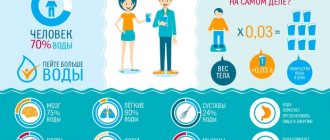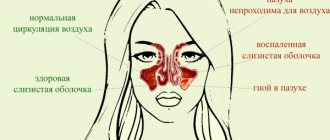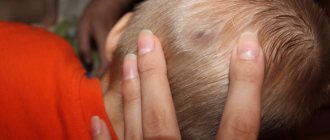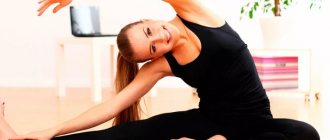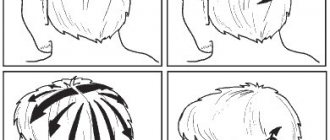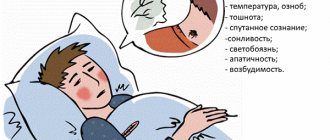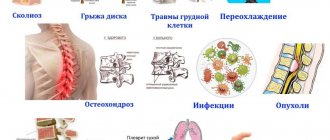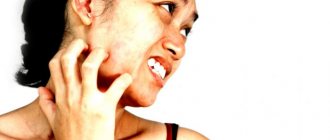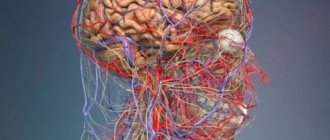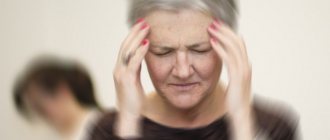Symptoms of tension headaches include:
In addition to pain directly in the head, tension pain usually affects the back of the neck and shoulders, down to the area between the shoulder blades. Both the neck and shoulders also become tense. Sometimes it seems that the neck is taking some unnatural position, for example, the head seems to be pushed forward or, conversely, tilted back.
In addition, discomfort may occur in the scalp. Sometimes such sensations are perceived as pain, sometimes as a burning sensation.
Pain and a feeling of tension can cover the entire head, neck and shoulders. And they can be localized only in one area. Moreover, this localization can be either stable or constantly shifting.
All of these symptoms can appear simultaneously, or they can come one at a time.
The intensity of pain varies from barely noticeable to extremely severe.
Pain may occur only occasionally. Or they can visit regularly and even be virtually constant.
Quite often, tension headaches occur simultaneously with migraines. In this case, additional symptoms appear. Namely:
- throbbing pain in the head;
- pain in only one side of the head;
- nausea to the point of vomiting;
- hypersensitivity to light and sounds;
- visual impairment.
Dangerous symptoms
There are a number of symptoms that develop along with pain in the back of the head, which are very alarming:
- body temperature has increased, despite the fact that there are no signs of a cold, acute respiratory viral infection or flu;
- there is pain in the neck or back, there is a feeling of “lumbago”;
- convulsions when sneezing or coughing;
- numbness or weakening of the muscle tone of the limbs occurs;
- along with pain in the back of the head, neck, shoulders and chest, there is shortness of breath;
- there is acute pain in the back and radiating pain under the shoulder blade;
- Acute pain in the back of the head and neck occurred in a pregnant woman or child.
If they are detected, you should immediately consult your doctor or, in a particularly serious condition, call an ambulance.
Vessels
Enlargement of the Jugular Vein in the Neck: Causes of Phlebectasia
Feb 03, 2020 Kokh V. A.
14225
Vessels
Jugular Vein Thrombosis in the Neck: Treatment
Jan 31, 2020 Kokh V. A.
7733
Vessels
Causes of tension headaches
Pain of this type always occurs against a background of nervous tension, which can be short-term acute stress, chronic anxiety (CA), depression, or insomnia.
Mental experiences lead to hypertonicity of the muscles of the head, neck, face, and shoulders.
Acute stress can cause sudden muscle spasms, while chronic anxiety can cause constant muscle tension. In either case, the muscles become excessively hard and painful. This leads to the development of tension headaches and its famous symptom, the feeling of a hoop squeezing the head.
Once a tension headache occurs, it often provokes the development of migraine, which is vascular in nature. Migraine itself has a myriad of causes. And it is well known that stress and the resulting muscle hypertonicity with tension headaches are one of the triggers of migraines.
Chronic back pain
Pain shoots, appears without a clear reason, disappears very slowly and difficultly. Chronic pain is now considered a biopsychosocial problem. A chronic problem often occurs in degenerative, infectious and rheumatic diseases. A person has severe back, head, and neck pain, often the pain radiates forward to the head (temples, frontal part), especially at night. The pain is worse when moving or tilting the head. A special group consists of people with chronic pain who, after multiple spinal surgeries, report only slight relief.
How to get rid of tension headaches
Tension headaches can occur occasionally, periodically, or be chronic.
The tactics for eliminating pain depend on how often they come.
The simplest and surest way to eliminate a headache is to take painkillers (Citramon, Paracetamol, Aspirin, Ibuprofen, Nurofen, etc.).
Non-drug approaches can also be used:
- you can close your eyes and massage your temples for a few minutes;
- take a hot shower;
- go for a professional massage of the cervical-collar area.
Sometimes it helps to just lie quietly. And sometimes, on the contrary, go for a run or move actively.
Non-drug methods are less effective than taking medications. But they make it possible to relieve minor headaches, as well as reduce the dose of medication for intense pain.
In cases where depression or persistent anxiety occurs, tension headaches often become virtually constant. Frequent use of painkillers, more than twice a week, can also contribute to the development of periodic pain into chronic pain. Especially when using medications with caffeine and/or codeine.
Getting rid of chronic headaches is much more difficult. And taking medications is not the best option here.
Taking large doses of painkillers or switching to stronger drugs is dangerous for health, since all such drugs, when used regularly, have a lot of severe side effects.
Unfortunately, achieving complete recovery from anxiety disorder or depression is extremely difficult. Some people simply cannot do this, since such mental disorders cannot be treated with medications alone.
However, it is still necessary to relieve pain in the head area. How?
- First of all, you need to master the technique of complete muscle relaxation.
- You can try doing a self-massage of the back of your head.
And finally, the most important thing.
Like all other physical manifestations of mental problems, be it anxiety, depression, VSD, chronic tension headache is largely obsessive in nature. Very often it occurs immediately after waking up, when a neurotic person, opening his eyes, is already prepared for the fact that he should have a headache.
The more a person suffering from certain physical symptoms of neurotic conditions thinks about these symptoms, the more clearly they show themselves.
Stop feeling like you are disabled and in need of some special, gentle lifestyle. Move more, take walks. Ignore the headache. And then she will gradually leave you.
Many people, regardless of age and social status, complain of discomfort and tension in the head. An unpleasant condition interferes not only with normal work and household chores, but also with restful sleep. Why does such a disorder occur and how to get rid of it?
p, blockquote 2,0,0,0,0 —>
- Causes of tension
- Symptoms
- Classification and signs of nervous tension
- Diagnostics
- Drug treatment
- other methods
- ethnoscience
- Prevention
Almost all people are susceptible to stress and may experience unpleasant emotions when communicating. If a person has to live for a long time in uncomfortable conditions, constantly experiencing negativity, then sooner or later the nervous system will fail. In addition, vascular diseases, tension headaches, and constant muscle strain may occur. To understand the reasons for the malaise, you need to consult a doctor. He will prescribe appropriate treatment and give recommendations.
p, blockquote 3,0,0,0,0 —>
How to get rid
Neck pain radiates to the head, back of the head, and ear - this is a serious symptom that requires a quick response: contacting a specialist, undergoing an examination and selecting an adequate comprehensive treatment.
Painkillers and anti-inflammatory medications
To relieve pain, the patient is prescribed painkillers and anti-inflammatory medications.
Nimesil
Available in powder form for the preparation of a medicinal suspension. Its main component is nimesulide, a substance from the group of non-steroidal anti-inflammatory drugs. Additionally, the following components were introduced into the medication: sucrose, ketomacrogol, citric acid, maltodextrin, orange flavoring.
It is recommended to take it for kidney diseases, osteochondrosis, periarthritis, intervertebral hernias, arthritis. The doctor selects the course and dosage for each patient individually. The medicine is not prescribed for spasms in the bronchi, rhinitis, inflammatory processes in the intestines, liver and kidney failure, bleeding, alcoholism and drug addiction.
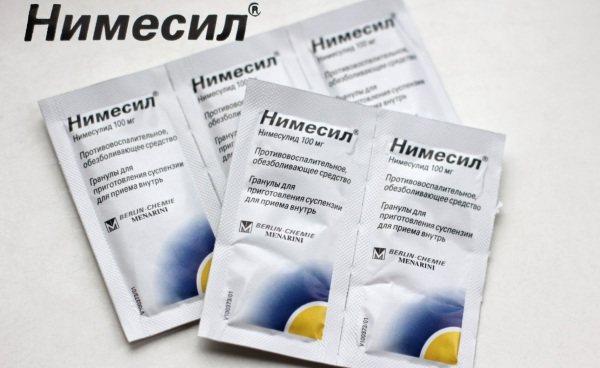
Failure to follow the recommendations may provoke the development of undesirable manifestations: decreased vision, headaches, dizziness, shortness of breath, nausea, vomiting, apathy, urination disorder, blood in the urine, signs of hepatitis, gastritis. At the pharmacy, 1 sachet of the drug can be purchased for 30 rubles.
Ibuklin
The drug is available in tablet form and contains 2 active ingredients: ibuprofen and paracetamol. It is thanks to this combination that the drug has analgesic, anti-inflammatory and antipyretic effects. The medication is prescribed for myalgia, neuralgia, back and joint pain, post-traumatic discomfort.
Take 1 tablet up to 3 times a day for no more than 5 days. You cannot prescribe medicine for stomach ulcers, bleeding in the digestive organs, kidney failure, blood ailments, damage to the optic nerve, inflammation of the intestines, children under 12 years of age and women in the 3rd trimester of pregnancy.
Exceeding the dosage is fraught with the development of the following symptoms: nausea, vomiting, headache, nervousness, anxiety, increased blood pressure, anemia, allergic manifestations. The price varies within 100 rubles.
Pregabalin
Pain in the neck that radiates to the head is associated with increased excitability, anxiety, and nervousness, it is recommended to take Pregabalin. The drug is produced in the form of capsules with the active ingredient of the same name. This substance helps contact the voltage-gated calcium channel in the central nervous system, resulting in an analthegic and anticonvulsant effect on the body.
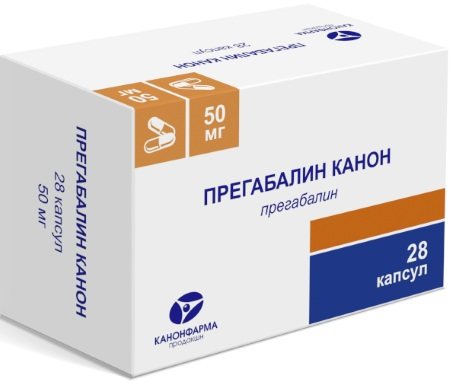
The drug is prescribed for neuropathic pain, anxiety, and fibromyalgia. Take the medicine at 150-600 mg, divided into 3 doses per day. Duration no more than 7 days.
You cannot prescribe the drug for intolerance to the components, hereditary pathologies, galactose and lactase intolerance. Undesirable symptoms include dizziness and drowsiness. Price 250 rub.
Flupirtine
Neck pain radiates to the head and this is due to muscle tension in the neck, then Flupirtine will help. This is a pain reliever available in tablet form. This drug contains flupirtine maleate, due to which the drug has an analgesic, neuroprotective and muscle relaxant effect.
The drug is indicated for painful spasms of the muscles of the musculoskeletal system, headache, post-traumatic discomfort, pain due to oncology. Take the drug 100 mg up to 4 times a day.
The course is individual. You should not take the medicine if you have cholestasis, liver disease, special sensitivity to the composition, myasthenia gravis, lactation, or alcoholism. The average cost of the drug varies within 500 rubles.
Tolperil
For neurological pain, muscle relaxants such as Tolperil are prescribed. The drug is available in tablet form and contains tolperisone hydrochloride as the main component.
This medicine is a centrally acting muscle relaxant, which, when entering the body, inhibits the conduction of impulses of primary afferent fibers and motor neurons, which ultimately leads to blockade of reflexes in the spine and spinal zone.
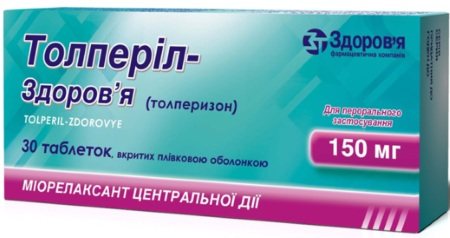
The drug is indicated for hypertonicity and muscle spasms, as an adjuvant therapy after surgery, and for ailments associated with arterial spasms. Take the medicine at 150-450 mg, divided into 3 doses. The course is individual. The drug is not recommended for use if the components are intolerant, myasthenia gravis, or for women who are pregnant or breastfeeding.
Among the undesirable manifestations, headache, muscle weakness, vomiting, nausea, abdominal discomfort, and allergies are most often observed. The average cost of the drug is 300 rubles.
Drugs to improve blood circulation in the brain
To improve blood circulation in the brain, the following drugs are prescribed:
Mexidol
The medicine is available in the form of a solution. The main component is ethylmethylhydroxypyridine succinate. It is thanks to this component that the drug has antihypoxic, nootropic, anticonvulsant and anxiolytic effects, and increases the body's resistance to stress.
The medicine is indicated for disorders of blood flow in the brain, traumatic brain injury, encephalopathy, autonomic dystonia, cognitive disorder, and heart attack. The drug is administered intravenously in a stream of 200-500 mg up to 4 times a day or intramuscularly in a dose of 200-250 mg up to 3 times for 14 days.
The drug should not be prescribed to patients with impaired liver and kidney function or intolerance to the components of the composition. Undesirable symptoms include allergies, dry mouth, and nausea. The price varies within 280 rubles.
Pentoxifylline
The drug is available in tablet form and solution. The main component is a substance of the same name. It is thanks to this component that the medicine improves microcirculation and acts as an angioprotector. The medication improves blood viscosity, stops the formation and adhesion of blood clots.
It is prescribed for blood flow disturbances caused by a stroke or heart attack, atherosclerosis, or viral neuroinfection. The solution is administered intravenously or intramuscularly, the dose and course are individual. Tablets are taken 1 pc. up to 3 times a day for 3 weeks.
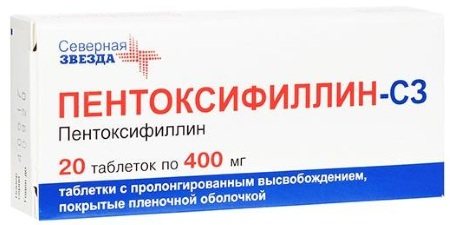
The drug should not be prescribed for acute heart attack, heavy bleeding, severe atherosclerosis, children under 12 years of age, pregnancy and breastfeeding. Failure to follow the recommendations provokes the development of the following symptoms: headache, dizziness, nervousness, drowsiness, insomnia. The cost of the drug varies within 100 rubles.
Massage
Neck pain that radiates to the head can be relieved with massage. With its help, it is possible not only to improve blood flow, but also to relieve muscle spasms. The cervical-collar area should be massaged. The effect can only be achieved if you undergo the procedure regularly.
A massage should only be performed by a qualified specialist who knows how and with what intensity to stretch the muscles. The minimum massage course is 10 procedures. After 2 weeks, you can repeat the course if the doctor recommends.
Massage should not be prescribed to people with fever and intervertebral hernias. People with hypertension should consult their doctor before seeing a massage therapist.
During the massage, you can use special ointments to increase efficiency:
- Turpentine. It helps improve blood flow and has a warming and analgesic effect on the body.
- Diclofenac. Treats with non-steroidal anti-inflammatory drugs, helps relieve pain and swelling.
It is better to carry out a massage after pre-warming the muscles. And you can do this after taking a hot shower, bath, sauna or steam bath. The emphasis during the procedure is on spasmodic and painful areas that can be felt.
Traditional medicine recipes
In addition to pharmaceutical drugs, safe traditional medicine can help you cope with neck pain.
The table below presents several recipes that will help eliminate discomfort in the neck, ears, and back of the head:
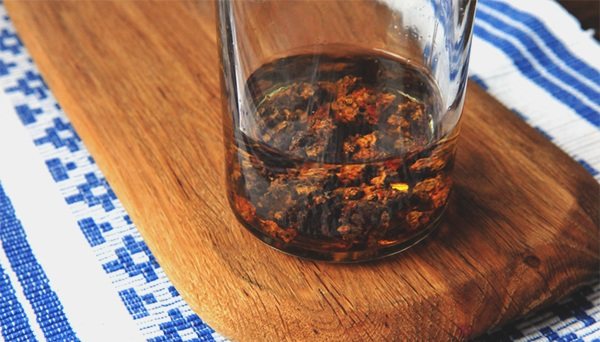
| Propolis tincture | You will need to take 30 g of propolis, grind it and pour ½ tbsp. medical alcohol. Leave the tincture for 7 days in a dark place, and then strain. Twice a day, place cotton wool, previously soaked in the tincture, in the ear on the side of the observed discomfort. | Duration of therapy is 10-15 days. |
| Apple or grape vinegar | 2 tbsp. l. vinegar, 4 tbsp. cold water, mix. Soak a cotton cloth in the solution and apply to your feet or temples. 10 minutes after the compress, the headache goes away. | Apply as needed. |
| Mint decoction | 1 tbsp. l. dry mint, pour 1.5 tbsp. boiling water, let it brew for 2 hours, strain and drink 2-3 tbsp a day. manages to get rid of stress and neuralgia. | Course 2 weeks. |
| Herb tea | For pain in the neck and back of the head, tea brewed from dry leaves of sage, mint or linden flowers will help. A pinch of dry herb per 1 tbsp. boiling water | Take when the pain does not subside. |
| Oregano tea | It helps to relax the muscles of the neck and back of the head, helping to normalize blood flow. Take 1 tbsp. l. dry herbs and pour 1 tbsp. boiling water, leave for 20 minutes and take ½ tbsp. in the morning and in the evening. | Course 14 days. |
Causes of tension
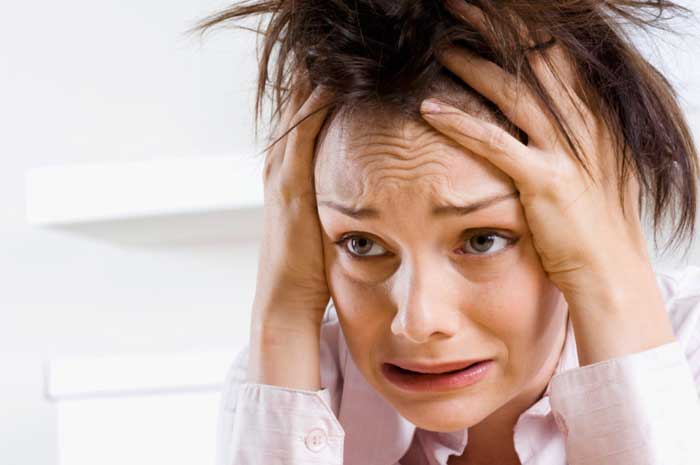
p, blockquote 4,0,0,0,0 —>
Constant tension and pain in the head can be caused by:
p, blockquote 5,0,0,0,0 —>
- Neurotic conditions, neurosis.
- Regular strain of the neck muscles.
- Disorder in the functioning of cerebral vessels.
- Overwork.
It is very important to identify the causes of tension in time and get rid of them. Otherwise, it can develop into severe neurosis. Experts note that unpleasant sensations in the head are both primary and secondary in nature.
p, blockquote 6,0,0,0,0 —>
With vegetative-vascular dystonia, victims complain of tension, pressure from inside the head, surges in blood pressure, increased sweating, hand tremors, and intestinal problems. This condition can occur in both children and adults. The cause of the development of pathology can be overwork, poor nutrition, hormonal imbalance, and cervical osteochondrosis.
p, blockquote 7,0,0,0,0 —>
Elderly people with cerebral atherosclerosis and hypertension also experience headaches. Here you can help patients by curing the underlying disease.
p, blockquote 8,0,0,0,0 —>
Secondary tension headaches can occur with:
p, blockquote 9,0,0,0,0 —>
- Sinusitis.
- Osteochondrosis of the neck.
- Eye diseases.
- Myositis.
Tension in the head and neck area can occur when a person holds an uncomfortable position for a long time. The neck muscles become overstrained, vascular spasm occurs, and pain impulses are sent to the brain. Then headaches are added to the tension.
p, blockquote 10,0,1,0,0 —>
There is another cause of discomfort - neurosis. In this condition, a person loses the ability to tolerate stress and control emotions. The nervous system is gradually depleted, which causes problems of both mental and neurological nature.
p, blockquote 11,0,0,0,0 —>
Impact of infectious diseases
In the case where children have pain in the back of their neck, it can be assumed that the child had a sore throat, which caused a complication called lymphadenitis.
This pathology also occurs in adults. The essence of the disease is inflammation of the lymph nodes located in the occipital region of the head. Therefore, palpation gives sensitivity to painful bumps.
If a sore throat is treated incorrectly, then in addition to inflamed lymph nodes, lethargy, chills, and intoxication appear.
There may also be meningitis, which causes muscle spasms on one side of the face, when the neck and back of the head hurt. It is also characterized by the appearance of increased body temperature, vomiting or nausea, and dizziness.
Symptoms
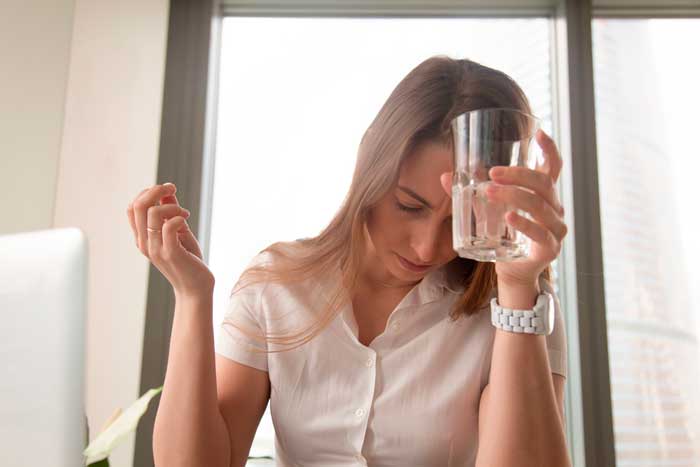
p, blockquote 12,0,0,0,0 —>
In neurotic disorders, the following types of pain are distinguished:
p, blockquote 13,0,0,0,0 —>
- Neuromuscular. It causes a feeling of compression of the skull.
- Neurovascular. Has a pulsating character.
With regular muscle strain, the disorder manifests itself:
p, blockquote 14,0,0,0,0 —>
- Heaviness in the head.
- Tightness of the neck muscles.
- Soreness of the scalp.
The pain is intense and affects the entire head. The attack can last quite a long time. The victim, due to a sore head, does not know how to relieve tension and distract himself from the discomfort. It is difficult for him to do any work, his memory and attention noticeably deteriorate.
p, blockquote 15,0,0,0,0 —>
If the main cause of tension is problems with the cerebral vessels, then the following occurs:
p, blockquote 16,0,0,0,0 —>
- Painful sensations in the temples, frontal and occipital parts.
- Noise, ringing in the ears.
- Lethargy.
- Sensation preceding vomiting.
If an attack flares up for no apparent reason, then it is probably triggered by severe overwork. Such pains have no localization and specific symptoms. Since this pain is of a psycho-emotional nature, it is classified as a neurotic condition.
p, blockquote 17,0,0,0,0 —>
Patients with neurosis experience:
p, blockquote 18,0,0,0,0 —>
- Increased sweating.
- Frequent heartbeat.
- Appetite disorders.
- Dizziness.
- Anxiety.
- Unreasonable fear.
- Fast fatiguability.
- Mood swings.
- Tearfulness.
- Dyspnea.
- Numbness of the limbs.
Interestingly, dizziness during neurosis has nothing to do with the functioning of the body. The dependence of its occurrence on the emotional state has been proven. Psychogenic dizziness begins with depression, panic attacks, and phobias.
p, blockquote 19,0,0,0,0 —>
Symptoms and first signs
The first symptoms of tension-type headache appear as slight pain, with which the person gradually gets used to it. The pain is moderate, which explains the practice of self-medication. In this situation, the attending physician can help, who will establish a diagnosis and prescribe treatment in the early stages, but due to mild symptoms, the patient does not pay attention to the pain and leads a normal life.
The attack can last from several minutes to several days. How long the pain will last depends on the individual characteristics of the body and the rate of production of painkillers.
The pain may be of a compressive nature, or may move from the forehead to the occipital region. Often pain occurs on both sides.
You can distinguish tension headaches from migraines or other pathologies by the nature of the manifestation: with tension headaches it is constant and monotonous, and with migraines it is pulsating.
Classification and signs of nervous tension
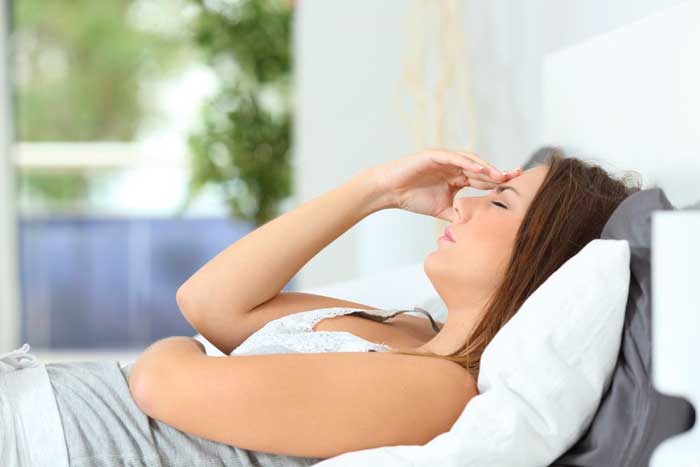
p, blockquote 20,1,0,0,0 —>
In order to respond to your body’s signals in a timely manner, you need to know what types of tension there are.
p, blockquote 21,0,0,0,0 —>
- Lung. Occurs in most people. During the day a person faces many problems. He gets irritated, angry, and remembers something unpleasant when meeting people he doesn’t like. But pleasant events quickly erase obsessive thoughts from memory, and the mood improves.
- Increased. Noticeably takes away the patient's strength. At the same time, an unsuccessful solution to some complex problem, experiencing stress, as well as constant mental work (for example, in people involved in serious business or politics) can cause an uncomfortable feeling.
- Strong. Has a negative impact on the patient's psyche. Signs of neurosis, dizziness and other symptoms appear, including loss of appetite, cephalgia, weakness, lethargy.
A person experiencing nervous tension experiences:
p, blockquote 22,0,0,0,0 —>
- Stiffness.
- Overexcitement.
- Aggression.
- Nervousness.
If the feeling of tension does not go away on its own, the sensations intensify, you need to take all possible measures to eliminate the disorder.
p, blockquote 23,0,0,0,0 —>
Diagnostics
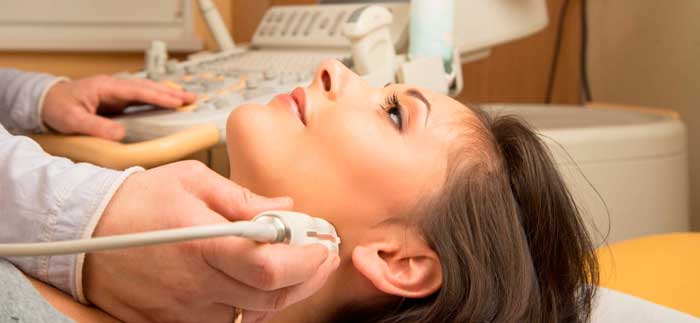
p, blockquote 24,0,0,0,0 —>
A pediatric neurologist treats tension pain in the head in children. If the problem occurs in an adult, he needs to contact a neurologist. After collecting anamnesis and examining the patient, the doctor can send him for diagnostics:
p, blockquote 25,0,0,0,0 —>
- X-ray of the neck.
- Computed or magnetic resonance imaging.
- Rheoencephalography.
- Ultrasound examination of blood vessels.
The main thing is to find the root cause of the disorder in order to get rid of unpleasant symptoms.
p, blockquote 26,0,0,0,0 —>
Forecast and recommendations
The prognosis depends on the cause of the discomfort and its severity. To avoid complications, you need to lead a healthy lifestyle:
- sleep at least 7-8 hours, use an orthopedic pillow for sleep;
- watch your posture, choose a work chair with a high back;
- exercise;
- adhere to a special diet;
- to refuse from bad habits;
- have a full rest.
Pain and numbness in the neck area can accompany a variety of pathologies. To cope with discomfort, you need to consult a doctor in a timely manner and strictly follow his recommendations.
How to quickly relieve numbness and neck spasms, watch our video:
Drug treatment

p, blockquote 27,0,0,0,0 —>
Patients seek medical help to relieve tension and headaches. If the problem is not related to vascular disease, ENT pathologies, osteochondrosis, myositis, then doctors prescribe to improve the condition:
p, blockquote 28,0,0,0,0 —>
- Antispasmodics that relieve spasms (Spazmalgon).
- Sedatives (tincture of motherwort, peony and valerian).
- Medicines that relieve anxiety and enhance brain function (Glycine, Pantogam).
- Vitamin complexes that strengthen and tonify a weakened body.
Only a doctor can prescribe a drug, determine the dosage and course of treatment. You should not take medicine without recommendations, as even the most harmless drug can cause side effects. Uncontrolled use of antispasmodics and analgesics causes severe headaches. It turns out that a person, wanting to relieve cephalalgia, provokes it himself. In such cases, the clinical picture is blurred - it will be difficult for the doctor to make an accurate diagnosis and prescribe competent treatment.
p, blockquote 29,0,0,0,0 —>
What could be the consequences?
It is very important to identify any change, even the most insignificant, in time. Detect areas of cerebral ischemia to stop the development of stroke. Against the background of hypertension and atherosclerosis, a stroke can occur. When an aneurysm ruptures, a cerebral hemorrhage occurs. All these are the most severe consequences of vascular diseases, which are accompanied by pain in the neck and head.
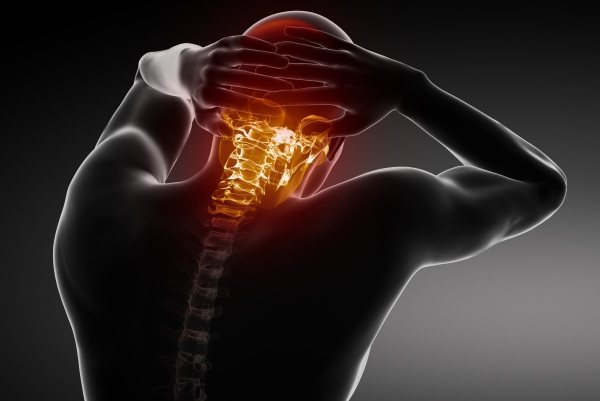
The probability of death from a stroke is very high; complex cases can result in disability.
Neck pain radiates to the head - this is a serious symptom that requires urgent consultation with a specialist, a comprehensive examination, diagnosis and therapy. This is the only way to prevent the development of a serious illness and avoid disability or death.
other methods
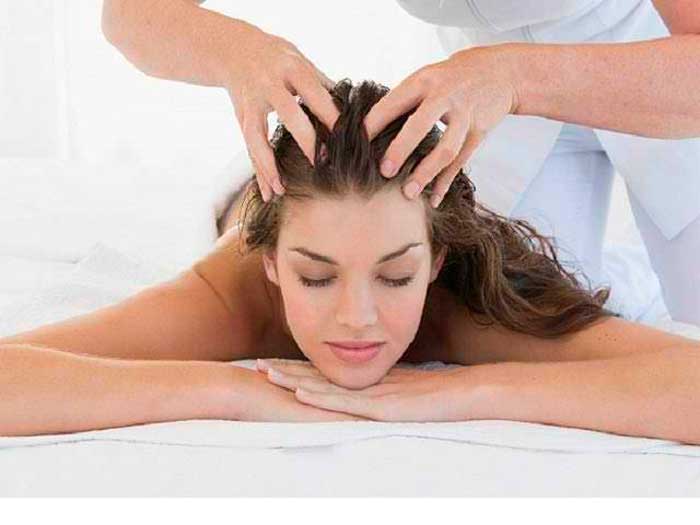
p, blockquote 30,0,0,1,0 —>
Experts are confident that most tension pains are associated with neuroses, which means that psychology and psychiatry can help get rid of headaches. These techniques allow not only to relieve symptoms, but to eradicate the very root cause of the disease. Working with the patient is aimed at helping him relieve tension and focus his attention on something else.
p, blockquote 31,0,0,0,0 —>
If the victim has tension in the body, which is considered a companion to neurosis, then the best medicines for it are physical exercise and relaxation massage.
p, blockquote 32,0,0,0,0 —>
Tension in the head associated with somatic manifestations is removed:
p, blockquote 33,0,0,0,0 —>
- Water procedures.
- Massages.
- Medicines for severe syndrome.
You can help yourself with simple exercises: place your hands on your neck and press forward until you feel tension in your shoulders. Alternately pressing, lower your arms, and then extend your fingers as much as possible. Relaxation helps a lot. To do this, you need to turn off the lights, create comfort and silence, and then:
p, blockquote 34,0,0,0,0 —>
- Sit in a chair, close your eyes, tilt your head back and relax as much as possible. At the same time, you can open your mouth slightly to relax the chewing muscles.
- Lie on your back and alternately relax your shoulders, neck, back, chest, thighs, calves, feet. No need to think about work and problems. You should abstract yourself from all thoughts and not worry about anything.
When there is tension in the head, when a certain area of the skull is very painful, acupressure techniques are used. In the painful area, squeeze the skin with your fingers and squeeze for a few seconds, and then release.
p, blockquote 35,0,0,0,0 —>
When you are nervous, you need to be able to switch. If possible, you should take a contrast shower or bath with lavender oil, which perfectly relieves tension. You can go to the pool, work out in the gym, draw, knit, sew.
p, blockquote 36,0,0,0,0 —>
Treatment of pain in affected areas
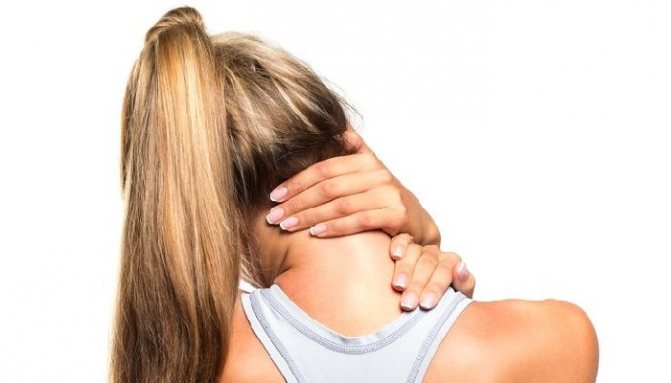
Of course, each patient comes with a unique problem, since the question of why the neck and back of the head hurts, the reasons and further treatment can only be explained by a specialist. Nevertheless, there are a number of effects on the body that can help you get rid of pain in most cases.
For example, when pain in the back of the head or neck occurs unexpectedly, you can resort to the following actions to relieve sensations:
1. It is necessary to ventilate the room by introducing fresh air. The brain will receive an influx of oxygen, which means blood circulation will improve.
2. Get a massage
.
3. If possible, you should take a horizontal position and relax.
4. It is advised to clear yourself of negative thoughts, breathe deeply and get rid of nervous tension.
IMPORTANT: Watch your diet; perhaps the body does not have enough omega-3 acids. These are useful microelements that can be obtained from fatty fish. A diet with such products helps prevent any inflammatory processes.
#!NevrologSeredina!#
The source of the problem is physical fatigue. A good way to give your muscles a chance to heal and bounce back is to remove the weight from the affected areas. It is recommended to rest, but you should avoid high pillows, which cause the spine to bend.
Ordinary ice can effectively reduce inflammation and relieve pain in the back of the head and neck. It is necessary to crush the ice and place it in a plastic bag. This bag can be placed in a pillowcase. You cannot replace cotton fabric with a terry towel because such a product is too dense; there will be no effective transfer of cold.
An option recommended by doctors is heating the disease area. With the help of heat, blood circulation can be significantly improved, muscles can relax and become toned. You need to take a damp towel made of natural fabric; any bottle of hot water will also do. You can resort to water procedures and simply take a warming shower. In any of the options, you need to remember that you cannot overheat the body, since an excessive amount of heat can become another cause of pain in the back of the head and neck.
An important skill is the ability to relax. Overexertion can be caused by emotional stress. You need to monitor what fuels stress - the rush to get to work, worries about household chores, relationships with loved ones, communication with superiors and other factors. When the external pathogen is identified, you can begin to look for a way out of the current situation. A person will forget what it’s like to have pain in the neck and back of the head after the emotional state normalizes. Relaxation, abdominal breathing, aromatherapy, progressive relaxation help to relax. The following tips will help with this:
- Choose a quiet place and make sure that no one will disturb you during the relaxation period;
- Sit in a comfortable position (lie down), close your eyes;
- Tighten and relax the muscles from the head, moving to the neck and the rest of the body gradually;
- It is important to perform the abdominal breathing procedure in a relaxed sitting position;
- It is necessary to take slow and deep breaths exclusively through the stomach. To feel the depth of breathing, you can place your palm on your stomach;
- Also exhale completely, pushing out oxygen using the stomach;
- The procedure is carried out in a few minutes without haste. Speed is fraught with hyperventilation. It should be carried out especially carefully if the neck and back of the head are numb.

Other opportunities to relax the body include yoga, various physical exercises, and meditation. Pleasant activities, such as a favorite hobby and pleasant music, can also have a positive impact. The tips help treat the causes of pain in the neck and back of the head.
ethnoscience

p, blockquote 37,0,0,0,0 —>
There are many effective recipes for how to relieve or reduce tension in the head using traditional methods, without resorting to medications. The following recipes will help relieve pain symptoms and calm the nervous system:
p, blockquote 38,0,0,0,0 —>
- 100 g of hawthorn fruits are poured with 2 cups of boiling water and simmered on fire for 15 minutes. Leave for 2 hours and take half a glass three times a day.
- Valerian tincture is taken 30 drops three times a day.
- Melissa is added to tea or brewed (a glass of boiling water is enough for a tablespoon of raw material). This plant relieves nerve spasms, normalizes sleep and improves brain activity.
- Valerian root, hop cones, motherwort, and mint are poured with boiling water in equal proportions. When the infusion has infused and cooled, take a third of a tablespoon three times a day.
- You can eliminate pain and tension by applying a cold compress (towel, handkerchief soaked in cold water, heating pad with ice) to the back of your head.
- Warm mint tea with honey helps a lot.
Prevention

p, blockquote 39,0,0,0,0 —>
In order not to experience unpleasant symptoms and to normalize your physical and mental state, it is recommended:
p, blockquote 40,0,0,0,0 —>
- Maintain a rest regime.
- Be outdoors often.
- Standardize your working day.
- Play sports, jogging, swimming, walking.
- Eat properly.
p, blockquote 41,0,0,0,1 —>
Most stress-related problems are caused by the person himself. If he does not know how to relax, is constantly busy with work, study, worries, then he cannot avoid neurosis and pain of tension. Intense stress and psychological problems upset the nervous system and result in unpleasant consequences.
Date of publication: 01/26/2018
Neurologist, reflexologist, functional diagnostician
33 years of experience, highest category
Professional skills: Diagnosis and treatment of the peripheral nervous system, vascular and degenerative diseases of the central nervous system, treatment of headaches, relief of pain syndromes.
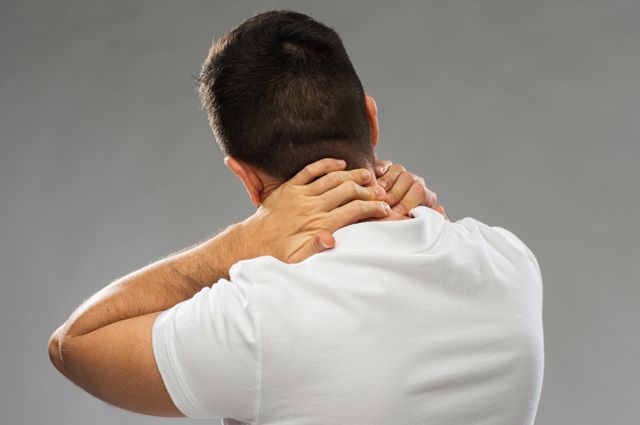
Treatment
If a person starts to have a headache from the neck, then the first thing he does is remember the name of suitable painkillers, which today the modern pharmaceutical market is simply replete with. Our population also actively uses folk remedies to help with headaches.
In situations where the pain syndrome does not appear often, is not systematic, and is not caused by any diseases of the internal organs or spine, then any anti-inflammatory and painkillers with a moderate medicinal effect on the body will do well.
There are several medications that have a fairly good therapeutic effect, but have certain contraindications and side effects:
- Ibuprofen.
- Diclofenac.
- Meloxicam.
- Ketoprofen.
Where does the pain come from?
Most often, changes in the three upper segments of the cervical spine are to blame for the appearance of cervicogenic headaches. The fact is that this area is innervated from the trigeminal nerve system, which also provides sensitivity to the tissues of the face, most of the soft tissues of the cranial vault, tissues and mucous membranes of the nose and mouth, teeth, as well as parts of the dura mater, therefore irritation of pain receptors in the area of the intervertebral joints, ligaments, muscles very often radiates to various areas of the head.
Diagnostic methods
Neck pain radiates to the head - this may be a symptom of hypertension or hypotension. If a specialist suspects these ailments, then blood pressure is monitored. An examination by a neurologist will help determine whether there is a connection between headaches and damage to the nerve roots.
If your vision is impaired, you need to consult an ophthalmologist, and if you have problems with hearing, consult an ENT specialist. If there is severe pain in the cervical spine, then for help they go to an orthopedist or massage therapist with a medical education.
You can help find the cause of your headache by:
- a thorough check of the arteries of the spine and blood vessels in the brain;
- identifying deformities of the vertebrae in the neck and upper sternum.
The following diagnostic examination methods are often recommended:
MRI
Using this technique, you can assess the condition of tissues, blood vessels, and the skeletal system due to the effect of a magnetic field on the body. During the procedure, a cross-sectional scan of the area of the body that is planned to be examined is performed.
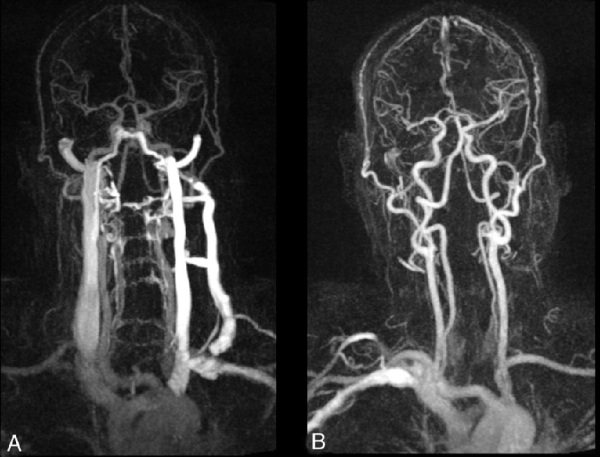
MRI of neck vessels with contrast. What does it show
In each image you can see the structure of bones, blood vessels, nerve endings and soft tissues. You can undergo an examination at diagnostic centers and it will cost an average of 3000-4000 rubles.
CT
This type of examination involves scanning an object using x-rays. With its help, you can detect even minor changes in internal organs, soft tissues, blood vessels, and bones. You can undergo the examination in the diagnostic room, the average price is about 1000 rubles.
REG or rheoencephalography
This is one of the informative studies of cerebral vessels. With its help, you can identify ailments that affect the brain and assess the condition of blood vessels. The method is recommended for people with suspected illnesses and for preventive purposes. You can undergo the test in the offices of medical institutions and it will cost an average of 500 rubles.
X-ray of the spine
Due to its invasiveness, the technique helps to obtain the most accurate data on the condition of the spinal column. The image can reveal abnormalities in the development of bone tissue, neoplasms, infections and inflammation, traumatic injuries, and degenerative-dystrophic lesions of the joints.
You can undergo the examination at a clinic or private medical institution, the average cost of the examination is 300-500 rubles.
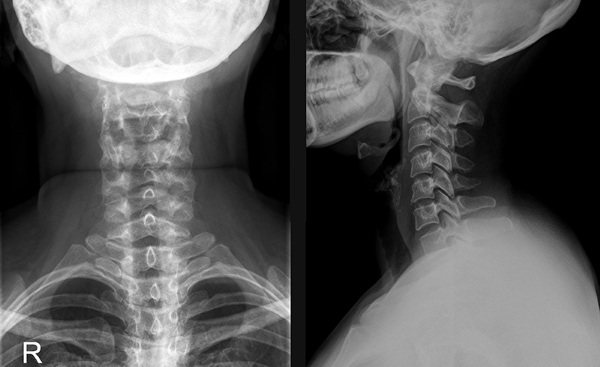
A diagnostic examination makes it possible to detect acute and chronic ailments that affect blood vessels, and to find the location of obstruction in them, including in the case of atherosclerotic damage. With a head injury, hematomas can be detected.
What causes neck muscle strain?
The most common reason is prolonged stay in an uncomfortable position. This often happens when working at a computer, traveling in a car or public transport, or sleeping in an uncomfortable position. And recently, doctors have come up with a new term - the so-called smartphone neck. When you hold a phone in front of your eyes, read from a tablet, or simply sit in front of the TV with your head tilted forward, the neck muscles and intervertebral discs experience enormous stress. In addition, in this position, tense, tense muscles can irritate the greater occipital nerve, the infringement of which, as well as irritation of the trigeminal nerve, can lead to headaches. Not only the nerve endings, but also the vertebral artery can suffer from muscle pressure. In this case, headaches will be accompanied by such unpleasant symptoms as dizziness, unsteadiness of gait, crawling, and a feeling of numbness on one half of the head.
The second reason for neck muscle tension is insufficient sleep. It takes at least 6–8 hours for the muscles to rest. And, as mentioned above, sleeping on a comfortable and orthopedically correct pillow is very important.
Careless movements of the neck can also lead to headaches. This happens especially often when a person makes a sudden movement of his head just after getting out of bed.
Who to contact
Cervicogenic headaches are typically treated by chiropractors. It is these specialists who are able to relax the neck muscles and return the vertebrae that have shifted due to overstrain to their place. At the same time, a good doctor will work not only with the problem area, but also with the entire body: with the thoracic, lumbosacral spine, muscles in the interscapular area and shoulder girdle, with the feet. After all, even a subluxation of the ankle joint, suffered in youth, over time can cause muscle spasm and lead to headaches on the side of the head opposite to the damaged joint.
However, before contacting a chiropractor, you will have to visit a neurologist. The fact is that it is very difficult to independently determine what causes a headache, so you cannot do without consulting a specialist. If the examination reveals that your headaches are caused by problems in the cervical spine, your doctor will most likely advise you to see a chiropractor.
Possible reasons
Pain in the neck area, radiating to the head and ear, is a common condition of modern people. This unpleasant symptom can be removed only after the root cause has been eliminated. And there may be several reasons.
Osteochondrosis
This is one of the common and common causes of discomfort in the skull, back of the head and neck. With this disease, tension in the back muscles is also observed. Symptoms of the disease appear gradually as the disease progresses.
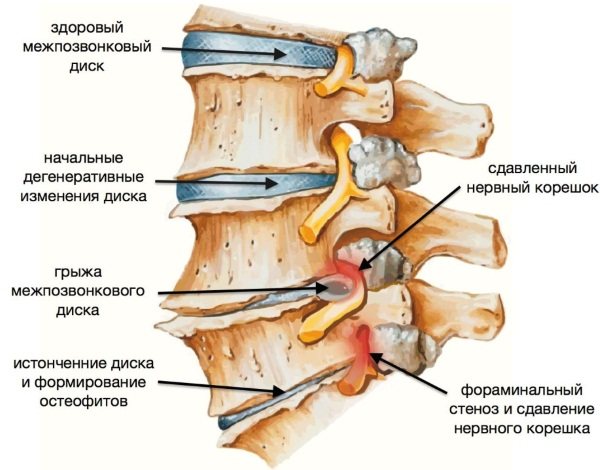
If you do not start timely treatment, then the following symptoms may be added to the pain in the neck and head:
- numbness of limbs and tongue;
- lack of coordination;
- deterioration of hearing, vision and memory.
Injuries
Previous injuries can also cause pain in the neck, which also radiates to the head.
For example, this symptom appears when:
- bruise or concussion;
- destruction or serious deformation of the spinal discs;
- injury to muscles and ligaments in the neck.
Pain in the head and cervical spine can be mild or, on the contrary, sharp, it all depends on the severity of the injury.
Discomfort may increase:
- if a person is on his feet for a long time;
- if he makes sudden bends or turns of the body;
- if the duration of his sleep is more than 10-12 hours.
Neuralgia occipital or cervical
Often people who seek help from a specialist complain of shooting pain in the cervical region, radiating to the head. This symptom may indicate a pinched nerve in the occipital region of the head.
With this disease, discomfort in the neck manifests itself on the right, left, and radiates to the ears, jaw and head. Pain is observed at the slightest movement of the neck, which is why a person with such a problem tries to keep the spine straight without making any movements.
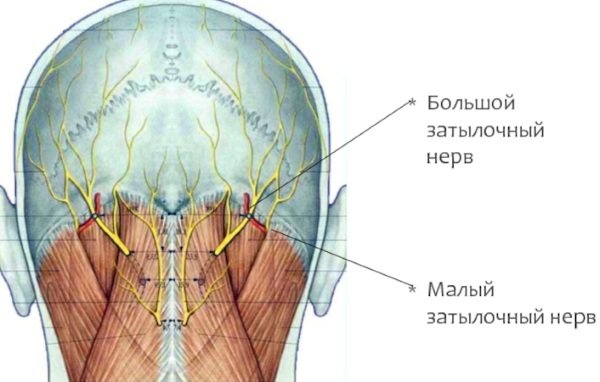
Occipital neuralgia provokes pain in the neck that radiates to the head
A person with neuralgia may also experience additional symptoms:
- feeling cold;
- numbness of tissue at the site of damage to nerve endings;
- excessive tearing;
- nausea.
The causes of neuralgia can be:
- diseases affecting the spinal column;
- infections and viruses;
- hypothermia;
- neoplasms localized in the brain or spine;
- severe and constant overstrain of the neck muscles;
- injuries;
- diabetes.
Frequent stressful situations and serious overexertion
If there is severe pain in the neck on the right or left side, radiating to the side of the head or in the back of the head, then such discomfort can be triggered by nervous exhaustion, stress, and excitement.
Pain from overexertion can be identified by the following symptoms:
- the pain is dull, there is a feeling of squeezing and squeezing;
- pain appears at any time of the day, rarely at night;
- the severity of symptoms is moderate.
If the cause is overexertion, then just relax, do breathing exercises and all the symptoms will disappear.
Blood flow disturbance
Hypertension provokes pain in the head, which manifests itself on the right, left, neck and back of the head. With this disease, pulsation appears for no apparent reason, and it disappears just as quickly.
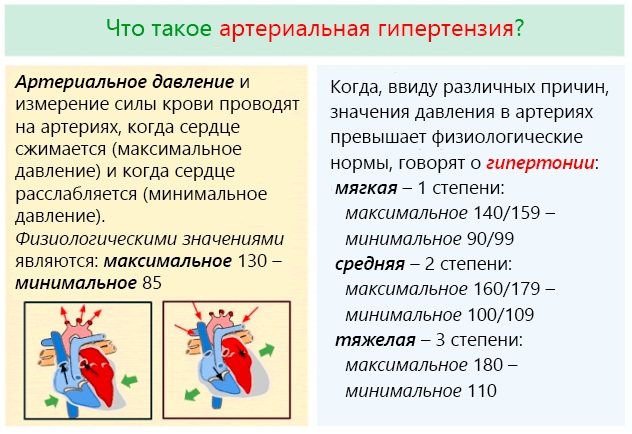
The risk of persistent hypertension, accompanied by high blood pressure, increases in old age and if:
- A person abuses smoking. People often complain that as soon as they smoke a hookah, their head starts to hurt. The thing is that after smoking your blood pressure rises sharply.
- Excessive alcohol consumption. A small dose of alcohol in people with healthy blood vessels will not cause any discomfort. But for hypertensive patients, drinking alcohol-containing drinks is strictly contraindicated.
- Poor nutrition. One has only to reconsider his diet, remove prohibited foods from it, and most of the problems, including hypertension, go away.
How to help yourself?
If the cause of the headache is really caused by tension in the neck muscles, you can alleviate your condition with the help of gymnastics. You can do it anywhere, even in the office, as a warm-up. To do this, get out from behind the computer and stand near the wall, pressing your heels, buttocks, shoulder blades and the back of your head against it, correcting your posture. Stretch your head upward as if you were trying to push the ceiling up, then relax. Do 10–15 of these movements. By the way, it is useful to perform such a warm-up every 30–60 minutes of working at the computer. After warming up, you can start exercising. Each of them needs to be done only three to five times, so the gymnastics will not take much time.
Place your hands on the back of your head. Press the back of your head into your hands without moving your head. Feel the muscles in your neck tighten. It is very important to try to make sure that the tension is felt throughout the entire neck, and not just in the area of the three upper vertebrae under the occipital bone. Hold this position for 5-10 seconds, then relax.
Place your hands on your forehead and press on them in the same way as in the first exercise.
Repeat the same thing, placing your palms on your temples: first on one side, then on the other.
Raise your shoulders as high as possible, as if you want to pull your head into them. Hold this position for 5-10 seconds, then relax.
Lower your shoulders and shoulder blades down, as if you are trying to reach your palms to the floor. Stay in this position for 5-10 seconds, relax.
Squeeze your shoulder blades together for 5-10 seconds, then relax.
Place your hands behind your back, clasping them together and placing them on your lower back. Pull your arms back, squeezing your shoulder blades together. At the same time, move your chin forward parallel to the floor. When moving your head, exhale noisily.
Turn your head to the side at a 45 degree angle. Fix the position and make the same head movement while exhaling as in the previous exercise. Repeat this exercise on the other side.
It is very important to perform all exercises smoothly, without pain - so that every movement gives you pleasure. There is no need to strive to do all the exercises perfectly the first time. If you enjoy doing exercises, you will be able to increase your range of movements each time.
But there are a number of other signs under which this insidious disease is hidden.
What to do for preventive purposes?
The basis of prevention lies in appropriate exercises.
Cervical region. In a sitting or standing position with your back extended, try to touch your ear to your shoulder, repeat several times.
Breast. Stand at the door, lean one hand on the door frame. For the greatest effectiveness of the exercise, it is advisable to bend your arm at the elbow 90 degrees. Lean forward.
Broad dorsal muscles. In a standing position, raise your arms straight up. From this position, lean alternately in both directions.
Trapezius muscle. While sitting, stretch your hands between your knees and try to touch the floor with them. Then straighten your back as much as possible.
Improved posture. Stand with your back to the wall, lower your head, press your shoulders and buttocks against the wall. Keep your arms extended, raise them as high as possible above your head, first forward, then spread them to the sides. This position affects the spine, trapezius and rhomboid muscles and the area of the shoulder blades. This exercise helps target muscles that are usually ignored by other types of exercise.
What is neurosis?
Neurosis is a protracted disease characterized by the inability of the nervous system to withstand stress. At the same time, a person’s mental performance is weakened.
The disease affects 20% of people.
Neurosis occurs as a result of chronic mental stress:
- stress;
- overwork;
- apathy.
A person suffering from neurosis becomes irritable and lethargic.
Patients describe pain or tension in the head as feeling like pressure from inside the skull.
Medicine distinguishes various types of neurosis:
- asthenic neurosis (neurasthenia);
- anxiety-phobic disorder;
- obsessive-compulsive neurosis, hysteria;
- somatic or organ;
- stress reactive disorders.
Osteochondrosis of the neck and vascular arteritis
Osteochondrosis of the neck can cause pinching of blood vessels and nerve cells that are directed to the head. In this case, the patient experiences impaired blood flow in the brain, resulting in unpleasant pain. Basically, the pain will only be on one side of the head.
Arteritis is a disease characterized by inflammation of the arterial walls. This disease is localized in the temporal region.
The inflammatory process can be triggered by injury, surgery, infectious, autoimmune diseases and processes. With arteritis, the patient experiences acute, burning, throbbing pain. Also, in parallel, a skin rash, itching, cephalalgia occurs, and body temperature becomes elevated.
Causes of headaches in neurosis
Headache with neurosis, neurasthenia and hysteria is a common symptom. The pain is localized and manifests itself in different ways, from mild pain to severe tension, depending on the cause. Moreover, each cause has its own symptoms.
Muscle pain (accompanying all types of neuroses):
- constant tension in the head (squeezing, feeling of wearing a tight headdress);
- scalp numbness or pain;
- a person’s mental activity is inhibited, the inability to concentrate or remember something.
- the pain is pulsating in nature;
- difficulty mentally working;
- appears together with nausea or weakness;
- pain in the temples, neck or forehead.
There is a headache after overwork and anxiety.
What to do with pain in the back of the head?
So what to do if the back of your head hurts? An unpleasant symptom can be temporarily eliminated by taking medications or using decoctions of medicinal herbs. However, all these are temporary measures, since a real cure can only be obtained after visiting a doctor and thorough diagnosis. If you find out what exactly is the cause of frequent occipital pain, you can solve this problem once and for all.
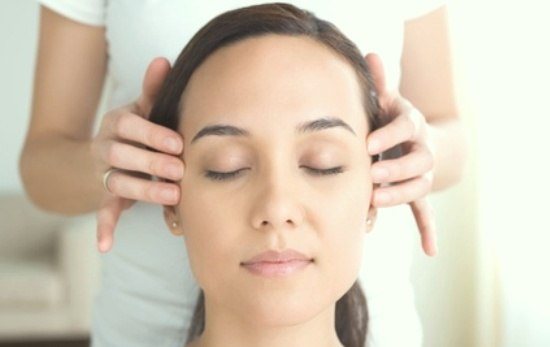
For the treatment and prevention of headaches, massage and exercise therapy are prescribed
When making a diagnosis, the doctor relies on the symptoms described by the patient. For example, a person may complain that the back of the head on the left hurts. If there is a suspicion of problems with the spine, an x-ray may be prescribed. Procedures (physical therapy, massage and manual therapy techniques) are prescribed as treatment and prevention of headaches. When diagnosed with osteoch?
Symptoms of neurosis
A nervous system disorder is characterized by a disturbance in a person’s psychological balance and physical activity.
The reasons for such violations:
- any event that traumatizes the psyche;
- chronic nervous tension;
- the impact on the psyche of a very joyful event (the birth of a child).
Factors causing neurosis:
- psychological (life in society, personal development);
- biological (insufficiency of certain neurophysiological as well as neurotransmitter systems, a person is susceptible to nervous disorders).
The disease manifests itself with one or more symptoms:
- headaches or dizziness;
- numbness of the limbs;
- insomnia;
- tense state;
- irritability, nervousness;
- depression, panic attacks;
- anxiety, obsessiveness;
- decreased mental activity;
- feeling of fear;
- loss of appetite and insufficient salivation;
- spots or circles before the eyes;
- dyspnea;
- lack of sexual desire;
- unstable blood pressure;
- sweating;
- sensitive perception of changes in temperature, light;
- mood swings;
- physical fatigue.
In some cases, patients report experiencing all the symptoms.
Infectious and neurological pathologies
In infectious diseases, the patient always experiences poisoning of the body with various substances and waste products of bacteria. Infections affect the vascular system and nerve cells, thereby provoking cephalalgia. Unpleasant sensations are diagnosed during the period of a cold, flu, sore throat or sinusitis. Also, in parallel, the patient will complain of other pronounced symptoms. In such a situation, it is worth going to a specialist for additional help and examination.
Also, severe pain is very often provoked directly by nervous overstrain. A patient may experience dull aching pain due to intense mental activity that is not accompanied by rest. In this situation, the patient becomes distracted and unable to think. In most cases, it is diagnosed in workers with a busy day or work activity. If acute intense pain occurs, then it is a migraine. It is accompanied by additional symptoms, such as:
1. Pain that can radiate to the nose, mouth, and eyes.
2. There are disturbances in auditory and visual function.
3. Problems with smell arise.
4. Dizziness.
5. The patient has a fear of bright light.
6. Nausea and vomiting.
Migraines can be periodic. In most cases, this type of headache cannot be treated with conventional analgesics. To get rid of migraines, you need to be examined by a neurologist who can prescribe the correct and safe course of therapy.
